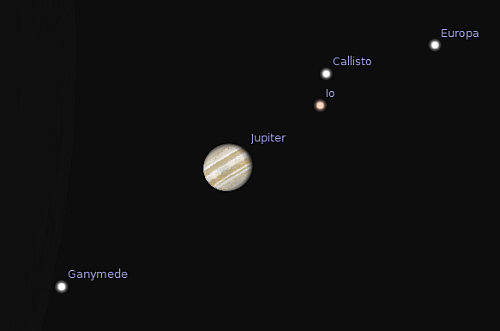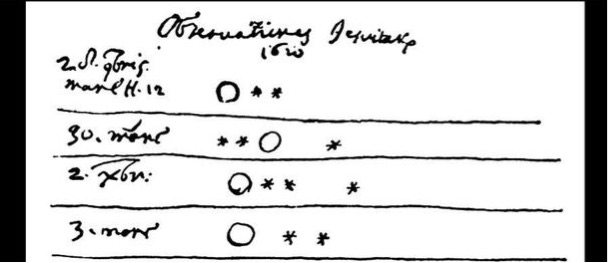Thanksgiving
This year we give thanks for an historically influential set of celestial bodies, the moons of Jupiter. (We’ve previously given thanks for the Standard Model Lagrangian, Hubble’s Law, the Spin-Statistics Theorem, conservation of momentum, effective field theory, the error bar, gauge symmetry, Landauer’s Principle, the Fourier Transform, Riemannian Geometry, the speed of light, and the Jarzynski equality.)
 For a change of pace this year, I went to Twitter and asked for suggestions for what to give thanks for in this annual post. There were a number of good suggestions, but two stood out above the rest: @etandel suggested Noether’s Theorem, and @OscarDelDiablo suggested the moons of Jupiter. Noether’s Theorem, according to which symmetries imply conserved quantities, would be a great choice, but in order to actually explain it I should probably first explain the principle of least action. Maybe some other year.
For a change of pace this year, I went to Twitter and asked for suggestions for what to give thanks for in this annual post. There were a number of good suggestions, but two stood out above the rest: @etandel suggested Noether’s Theorem, and @OscarDelDiablo suggested the moons of Jupiter. Noether’s Theorem, according to which symmetries imply conserved quantities, would be a great choice, but in order to actually explain it I should probably first explain the principle of least action. Maybe some other year.
And to be precise, I’m not going to bother to give thanks for all of Jupiter’s moons. 78 Jovian satellites have been discovered thus far, and most of them are just lucky pieces of space debris that wandered into Jupiter’s gravity well and never escaped. It’s the heavy hitters — the four Galilean satellites — that we’ll be concerned with here. They deserve our thanks, for at least three different reasons!
Reason One: Displacing Earth from the center of the Solar System
Galileo discovered the four largest moons of Jupiter — Io, Europa, Ganymede, and Callisto — back in 1610, and wrote about his findings in Sidereus Nuncius (The Starry Messenger). They were the first celestial bodies to be discovered using that new technological advance, the telescope. But more importantly for our present purposes, it was immediately obvious that these new objects were orbiting around Jupiter, not around the Earth.

All this was happening not long after Copernicus had published his heliocentric model of the Solar System in 1543, offering an alternative to the prevailing Ptolemaic geocentric model. Both models were pretty good at fitting the known observations of planetary motions, and both required an elaborate system of circular orbits and epicycles — the realization that planetary orbits should be thought of as ellipses didn’t come along until Kepler published Astronomia Nova in 1609. As everyone knows, the debate over whether the Earth or the Sun should be thought of as the center of the universe was a heated one, with the Roman Catholic Church prohibiting Copernicus’s book in 1616, and the Inquisition putting Galileo on trial in 1633. …





